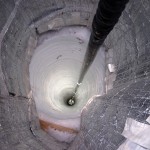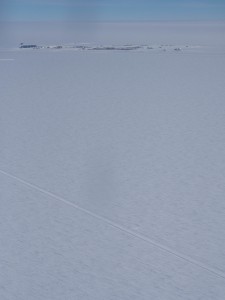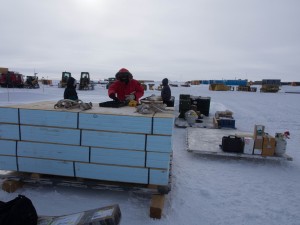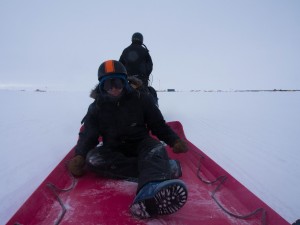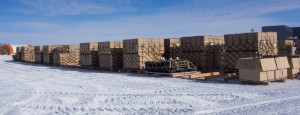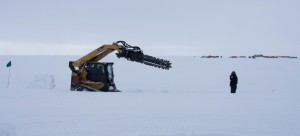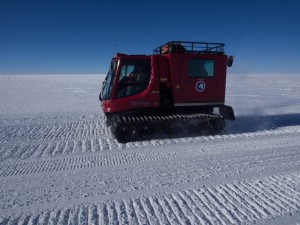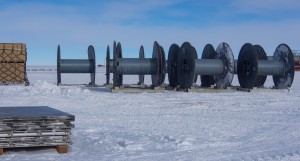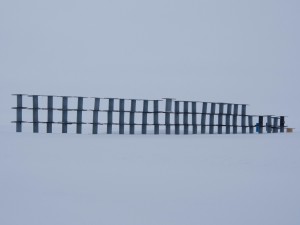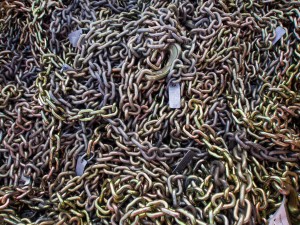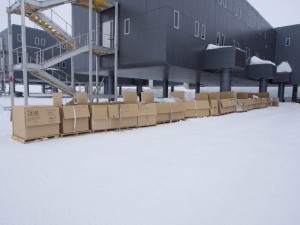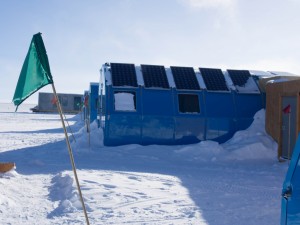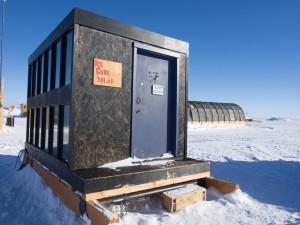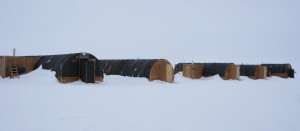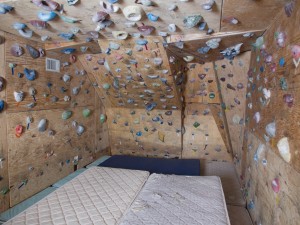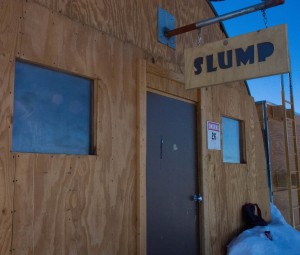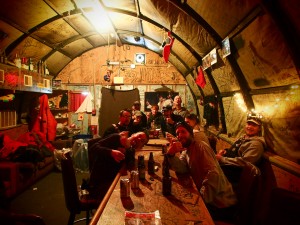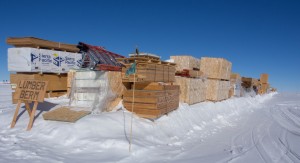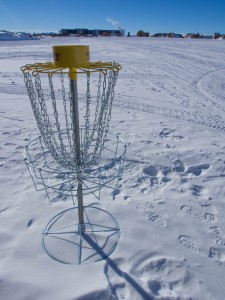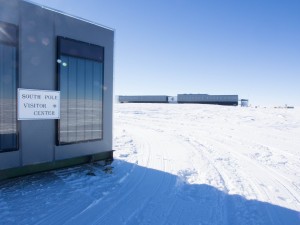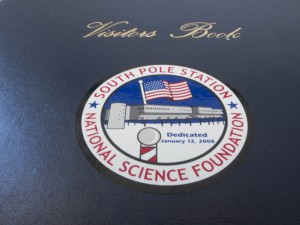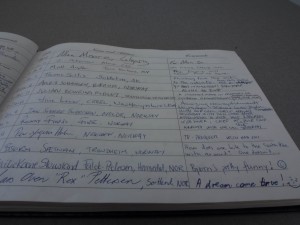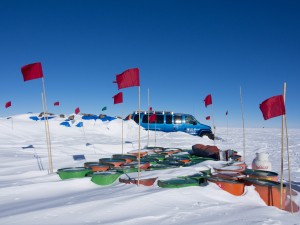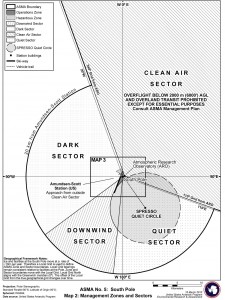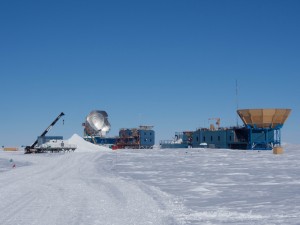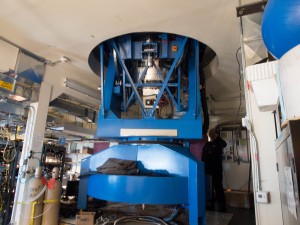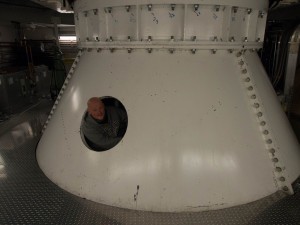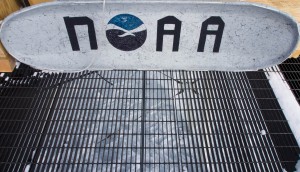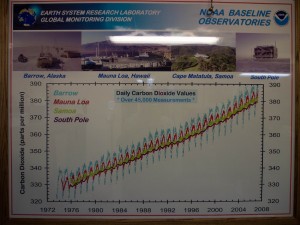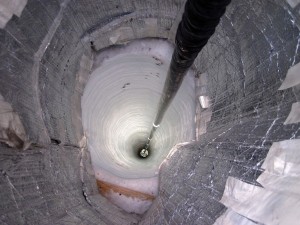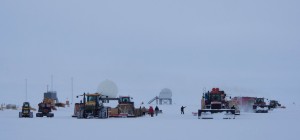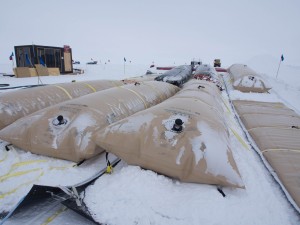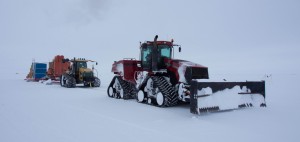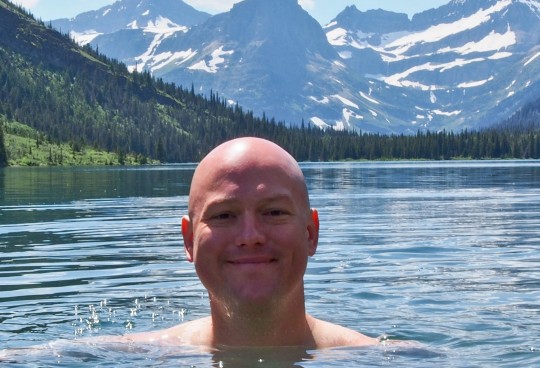Looking out the side window of the Twin Otter we finally get a glimpse of the South Pole.
There is a sprawl of buildings and supplies that surround the main station.
A perfectly straight track from the South Pole Traverse extends from the station into oblivion to where it originated.
The pilot puts the plane down like he’s done it a million times.
We slowly taxi up to the fuel resupply building.
When the side door opens up, the stuffy smell of the plane gives way to the cleanest, crispest air I’ve ever smelled.
Its 20 below and I’m covered with a hat, neck gaiter and goggles along with three layers of clothes.
It’s time to unload the plane and haul everything back to our cargo line.
In the field the only way to haul things from place to place is a banana sled pulled by human back and shoulders.
We now have a snow mobile with a large red sled hauled behind to carry our cargo.
Even better than hauling cargo, is when there is space on the sled for us.
The first time I hopped on the sled and zoomed around the hard packed snow trying to hold on to the rope handles, I knew I had arrived.
It’s impossible to not have a smile ear to ear, but it covered in a neck gaiter for no one to see.
The snow machine passes the expansive cargo line full of pallet upon pallet of netted equipment.
We dodge the huge grooming roller and two dozen comparably odd devices.
Off in the distance a man helps a heavy equipment operator navigate a humongous chainsaw thing that cuts ditches in the snow.
A Piston Bully grinds its way past us at about a 1/16th of a mile an hour.
We pass a pile of huge spools that once contained lord knows what kind of wire.
Maybe they will be added to Spoolhenge on the outskirts of the compound.
This monument to electrical wiring is visible from thousands of feet above as we fly in.
While walking the last bit to the station I get a more intimate view of a huge triwall box full of chains that probably weighs a few thousand pounds.
Outside the Destination Zulu entrance, I pass the row of boxes that separate all of the recycling types. Everything is separated before it is shipped off.
Wood, metal, electronic parts, food garbage, glass, plastic and my favorite Skua.
A Skua is a bird in Antarctica that is a scavenger. The word has grown to mean to grab, take or reuse.
It’s like the inventive reuse and recycle version of the word Smurfy.
There’s a thrift store of free stuff that’s left at the station for anyone to grab.
That building is called the “SKUA”.
You should use it, it’s catchy.
I’m going to try and bring this one home with me and use it in the states.
We’ll see how it goes.
While the South Pole is dominated by the main station, it is surrounded by countless buildings, experiments, supplies and vehicles.
Since we are a transient science group we don’t get a bedroom in the station.
We sleep in buildings called Hyper Tats.
They are essentially mobile hallways with a door at both ends and bedrooms along both sides.
There is no running water at the hyper-tats, so there’s an outhouse building nearby.
There are also older structures called Jamesways that were commonly used by the Armed Forces.
They still exist and are used for multiple purposes around the station.
For example there is a climbing gym in one of the Jamesways.
It’s more of a bouldering wall because it’s not that tall but who cares!
That the South Pole even has a climbing wall is awesome!
The Slump is a smoking lounge that is made out of a very character filled Jamesway.
This place is covered in decades of graffiti and old Janis posters.
It feels like someone’s awesome basement party.
Beyond the Jamesways are burms of supplies that go on and on, row after row.
Everything that has arrived at the South Pole in the past is out there somewhere.
I even found a Frisbee golf disc goal.
How about a round of Folf at the South Pole?
That’s got to be on every Missoulian’s bucket list!
On the flip side of the enjoyment coin is the “South Pole Welcome Center”.
This is the only place that tourists can go inside once they have finally arrived at the pole.
It is about 20 feet by 20 feet, but it’s warm.
There is a guest book that visitors sign like they are at a wedding.
The book is filled with rows of names from all over the world .
It’s got to be a spectacular formality after a once in a lifetime trip.
There’s not much tourism to the South Pole but they do come.
It costs $50,000 to fly to the South Pole and hang out for four hours.
What a bizarre way to spend that much money.
But you can always try to ski the 1000 miles from the coast instead.
Or how about driving to the South Pole.
A group last year tried to drive a 6 wheel, beefed up van and before they could leave the Pole the transmission died.
The van is still there with all the fuel barrels they were hauling.
The people are still mandated to come back, fix it and drive the van back to the coast.
Can you imagine a worse place to have car problems?
Anyone want to take a stab at changing a transmission outside at the South Pole?
I’m sure they could use some help.
The real purpose of our presence at the South Pole is science.
The area surrounding the Pole is split in three main and very specific sectors.
There is the Quiet Sector where they try to minimize vehicle movement and noise.
Its focus is monitoring for seismic activity.
The South Pole is one of the quietest places on earth.
The equipment can recognize earthquakes, volcanos, nuclear blasts and other explosions across the globe.
The SPRESSO science project drilled a hole a thousand feet deep and dropped monitoring equipment in the ice to get rid of wind and ambient noise.
There is also a Dark Sector where all the telescope science happens.
During the winter when its dark 24 hours a day, there is not allowed to be any lights visible in the Dark Sector.
It has a few of the most technologically advanced telescopes on earth.
The South Pole is the most ideal place to view the sky.
While this sounds crazy, Antarctica is a desert.
It’s actually the driest place on earth.
All the moisture freezes instead of staying suspended in the air so it’s perfectly clear.
The air has something like 2% humidity.
Compare that to Cincinnati in August.
The 10 meter telescope studies what the universe looked like after the big bang.
They are also studying dark energy and all the other trippy astronomy based things that I don’t understand.
The telescopes monitor parts of the electromagnetic spectrum that the human eye can’t see.
I think it is set to look approximately 180 million light years away.
It’s a bit much for us simpletons to fathom.
It was still great to go see it.
When you don’t understand what something does, you climb inside of it.
At least that’s what I do.
Lastly there is the Clean Air Sector which is up wind of the station so measurements are as pure as possible.
It is basically the cleanest air on earth.
There is a NOAA station in this sector which monitors carbon dioxide levels.
This remote station and others in Barrow Alaska, American Samoa, Greenland, Trinidad Head CA and the top of Mauna Loa in Hawaii are used to get baseline CO2 levels.
These remote places have the least chance of having the air spiked with pollution of anywhere on earth.
Lastly there is also a project called Ice Cube.
They drilled a hole thousands of feet into the ice with hot water drills and put monitoring equipment down there.
The project detects neutrinos which are invisible high-energy particles that can only be detected when they interact with the deep, dark ice below the Pole, producing a blue light.
The science going on here is profound and world class.
Lastly I got to see the South Pole Traverse arrive after its journey.
There is a 1000 mile unpaved path from McMurdo to the South Pole.
The crevasses have been filled with snow and the route compacted as well as possible.
But it’s still nothing but snow, ice and a whole lot of Antarctica!
Through the years all fuel and supplies were sent via aircraft.
I’ve read that for every gallon of fuel at the South Pole it took two gallons to get it there.
When all of the costs of transit and logistics are taken into account, a gallon of fuel costs over $30 at the South Pole.
Two enormous tractors are chained together so there is always traction.
Then industrial strength plastic sheets called Magic Carpets are attached and all the supplies loaded on for hauling.
The trip from McMurdo to the South Pole takes over a month.
Well, that’s about as comprehensive as I can get.
I hope I didn’t lose all of you.
I really couldn’t take it all in either but it was fun trying.
It’s been a great run, but it’s almost over.
Soon I’ll make like the South Pole Traverse and leave.
To Life
